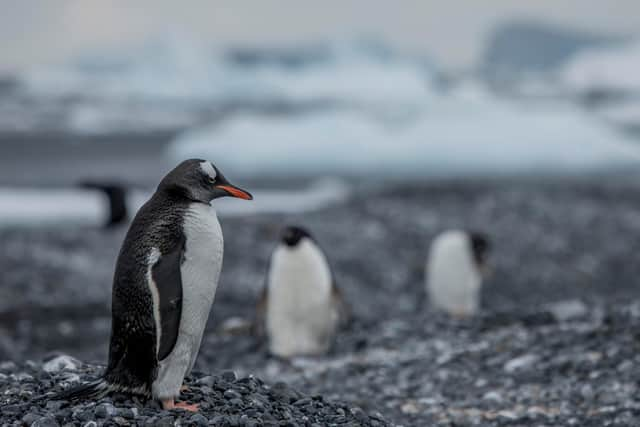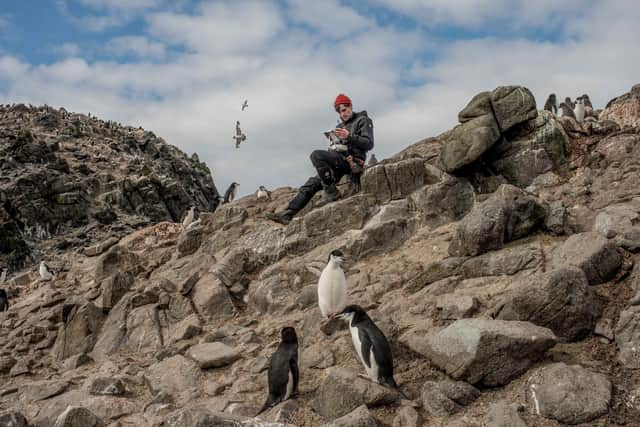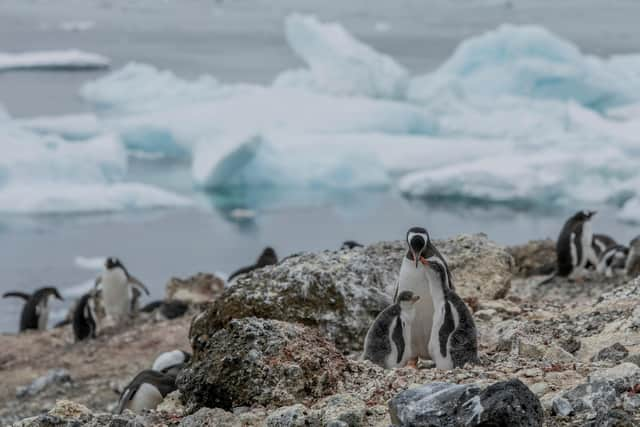Watch: Penguins set up home in Antarctic regions that were once too cold as climate change melts ice
New colonies of gentoo penguins have been found for the first time at Andersson Island, on the east side of the Antarctic peninsula, and in an unexplored archipelago just off the area’s northern tip.
The findings have been reported during the first days of a scientific voyage to the icy continent by international environmental campaign group Greenpeace.
Advertisement
Hide AdAdvertisement
Hide AdThese are some of the southernmost records for the species breeding on the eastern side of the Antarctic peninsula, where until recently it was far too icy for gentoos – which prefer more temperate regions – to successfully raise chicks.


Before this discovery, only one solitary gentoo nest had been found this far south, but researchers have now discovered a colony of 75 chicks on Andersson Island.
Scientists from New York’s Stony Brook University in the US, who have joined the Greenpeace expedition, have been carrying out surveys in the polar region since their arrival earlier this week aboard the charity’s ship Arctic Sunrise.
They say the new sightings show evidence that gentoo penguins – a species most abundant in the warmer sub-Antarctic – are continuing to move southwards as the climate crisis impacts the continent.


Dr Heather J Lynch, professor of ecology and evolution at Stony Brook University, is one of the mission’s leaders.
She said: “On this expedition we’re surveying parts of the Antarctic peninsula where penguin colonies have been spotted from satellites but have never explored by foot.
“Mapping out these remote archipelagos will give us a better understanding of how the region’s penguins are responding to rapid climate change.
“As expected, we’re finding gentoo penguins nearly everywhere we look – more evidence that climate change is drastically changing the mix of species here on the Antarctic peninsula.”
Advertisement
Hide AdAdvertisement
Hide Ad

Louisa Casson, from Greenpeace’s Protect the Oceans campaign, is also aboard the Arctic Sunrise.
“This is the climate crisis happening right in front of our eyes,” she said.
“In the Antarctic, one of the most remote places on earth, we are seeing a gentoofication process where this species of penguin is spreading into new habitat and breeding further south – a biological manifestation of sea ice loss.”
Penguins are considered a sentinel species and a great indicator of the health of the Antarctic ecosystem.
The iconic flightless birds are experiencing significant changes in the region due to the rapidly warming environment and industrial fishing.
A recent expedition to the Antarctic found that chinstrap penguin colonies at Elephant Island had collapsed, with some suffering losses of as much as 77 per cent in the last 50 years.
The research team is undertaking the first-ever counts of penguin colonies on remote islands of the eastern Antarctic peninsula, filling vital data gaps about the survival status of these much-loved animals.
Greenpeace has accused international leaders of repeated failure to create ocean sanctuaries in Antarctic waters.
Advertisement
Hide AdAdvertisement
Hide Ad“Governments need to agree a new Global Ocean Treaty to deliver protection for at least 30 per cent of the world’s oceans by 2030 – and they must get to work by protecting the Antarctic’s waters,” Ms Casson added.
“Penguins and people across the world can’t wait. We need politicians to get ocean protection done now.”
A message from the Editor:
Thank you for reading this article. We’re more reliant on your support than ever as the shift in consumer habits brought about by coronavirus impacts our advertisers.
If you haven’t already, please consider supporting our trusted, fact-checked journalism by taking out a digital subscription.
Comments
Want to join the conversation? Please or to comment on this article.
